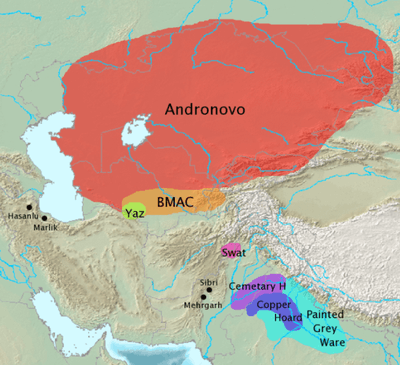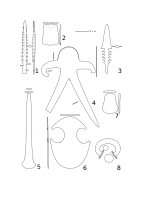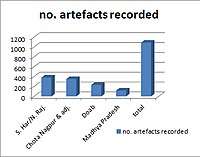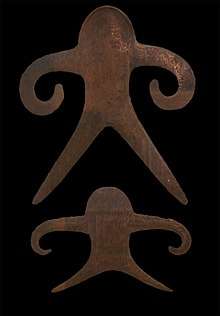Copper Hoard Culture
Copper Hoard Culture describes find-complexes which occur in the northern part of the Indian subcontinent. These occur mostly in hoards large and small and are believed to date to the later 2nd millennium BCE, although very few derive from controlled and dateable excavation contexts. A fragment of an anthropomorph came to light in controlled excavations at Lothal and a second one at Saipai Lichchwai, Etawah district. The doab hoards are associated with the so-called Ochre Coloured Pottery (OCP) which appears to be closely associated with the Late Harappan (or Posturban) phase.

As early as the 19th century, stray hoard objects became known and established themselves as an important find group in the two-river land of northern India. The dating is unclear. These hoard artifacts are a main manifestation of the archaeology of India during the metals age. Many are deposited in the Kanya Gurukul museum in Narela/Haryana.[1]
Exploration
The first Indian Copper Hoard harpoon was published in 1822. In a milestone publication B.B. Lal published 35 from the Gangetic basin, from the central peninsula and the eastern part of India.[2] In 1985 Paul Alan Yule published 1083 examples from 'Copper Hoards' but also other peninsular prehistoric metal finds.[3] These added a new group: those from southern Haryana and northern Rajasthan. By 1992 284 further examples followed specifically of the Copper Hoard types.
 Selected hoard artifacts from 1-2 South Haryana, 3-4 Uttar Pradesh, 5 Madhya Pradesh, 6-8 South Bihar-North Orissa-Bengalen.[4]
Selected hoard artifacts from 1-2 South Haryana, 3-4 Uttar Pradesh, 5 Madhya Pradesh, 6-8 South Bihar-North Orissa-Bengalen.[4] Indian Copper hoard artifact from Rewari, Haryana is probably not a use-object but more likely had a religious function.
Indian Copper hoard artifact from Rewari, Haryana is probably not a use-object but more likely had a religious function. Recorded Indian Copper hoards objects, statistic.
Recorded Indian Copper hoards objects, statistic.
Regional find-groups
Four regional find-groups are identifiable with their characteristic find-types. Characteristic hoard-finds from South Haryana/North Rajasthan (recorded: 383) include flat axes, harpoons, double axes, swords with so-called antenna grips and others. In the Ganges-Yamuna Doab (235) related types occur. Those from Chota Nagpur differ (235) entirely from these. They include finely worked pieces, and mostly look at first like axe-heads but are probably ingots. Fewer are those known from Madhya Pradesh (120), although originally there were some 424 from the Ghangaria hoard alone. Of the four find groups, the largest number derives from southern Haryana, especially from Hansi, 120 km west of Delhi [5] These are purchases and are not excavated. R.A.E. Coningham believes that one of the largest hoards is that from Daimabad with 60 kg.[6] It is an isolated contemporary phenomenon with little to do with the four main find-groups. Several writers do not distinguish between any early copper-based artefacts and the more narrowly defined Copper Hoards.
Characteristics of the artefacts

Since most show no clear signs of antique use-wear, often are oversized, or paper thin, they appear to be dedicatory and not use-implements.
The copper ore used derives from different ore ranges in Rajasthan (Khetri), southern Haryana, Bihar/West Bengal/Orissa (especially Singhbhum) as well as Madhya Pradesh (Malanjkhand), to judge from the proximity to the find spots.
Hoard objects contain from 78-99% copper. Six[7] contain up to 32.9% iron. Artefacts from Haryana show the greatest chemical variation. Those from Ghangharia are chemically the most homogeneous. Variations in the amount of different constituent metals are considered to be unintentional. Harappan metallurgists seem better able to produce usable alloys.
Certain copper artifacts from the late 3rd millennium contexts in Oman resemble the anthropomorphs of the Indian Copper Hoards.[8]
Interpretations of the artefacts
The different assemblages are known mostly by only their metallic artifacts, and thus the term 'culture' is misleading. The anthropomorphs have been explained as a vajra, that is a divine weapon fashioned for the Vedic and later Hindu deity Indra.[9] Considering the find circumstances and constituent hoard patterns, Yule found no evidence for this interpretation, or tell-tale use-wear, or traces of the wooden handle affixed to the anthropomorphs. Interpretations of the anthropomorphs as throwing weapons [10] ignore the find circumstances of associated hoard objects, not to mention the weight (up to 7 kg) of certain examples. Form follows function. P. Kuznetsov associates this artefact with the vajra of Indra, also noting similarity with a symbolic cudgel-scepter found in a burial of the Yamnaya culture of the Eurasian steppes.[11]
Moreover, when in the 1st century BCE the iconography of Indra took form, the memory of Vedic weapons had since vanished. Thus the vajra of Hindu art appears to cite the keraunos (thunderbolt) of the Greek deity Zeus.[12]
Several hoard artifacts have turned up without an archaeological context, which raises doubts about their authenticity.[13] Although on their discovery frequently questioned, today few voice doubts about the four Daimabad copper finds.[14]
References
- Paul Yule, The Bronze Age Metalwork of India, Prähistorische Bronzefunde XX,8 (München 1985), ISBN 3-406-30440-0 http://archiv.ub.uni-heidelberg.de/savifadok/volltexte/2011/1895/
- B.B. Lal, Further Copper Hoards from the Gangetic Basin and a Review of the Problem, Ancient India 7, 1951, 20-39
- Paul Yule, The Bronze Age Metalwork of India, Prähistorische Bronzefunde XX,8 (München 1985).
- Mallory, J. P.; Adams, Douglas Q. (1997). Encyclopedia of Indo-European Culture. Taylor & Francis. p. 310. ISBN 9781884964985. Retrieved 7 June 2019.
- Paul Yule, Addenda to "The Copper Hoards of the Indian Subcontinent: Preliminaries for an Interpretation", Man and Environment 26.2, 2002, 117–120 http://archiv.ub.uni-heidelberg.de/savifadok/volltexte/2009/510/.
- in: F.R. Allchin (ed.), The Archaeology of Early Historic South Asia (Cambridge 1995) 72.
- P. Yule/A. Hauptmann/M. Hughes, The Copper Hoards of the Indian Subcontinent: Preliminaries for an Interpretation,Jahrbuch des Römisch-Germanischen Zentralmuseums Mainz 36, 1989 [1992] 262-263 Tab. 4 & 5 http://archiv.ub.uni-heidelberg.de/savifadok/volltexte/2009/509/.
- Paul Yule, Beyond the Pale of Near Eastern Archaeology: Anthropomorphic Figures from al-Aqir near Baḥlāʾ, Sultanate of Oman, Man and Mining – T. Stöllner et al. (eds.) Mensch und Bergbau Studies in Honour of Gerd Weisgerber on Occasion of his 65th Birthday, Bochum, 2003, 537–542 http://archiv.ub.uni-heidelberg.de/propylaeumdok/volltexte/2008/109/ also under the same title in Pragdhara 14, 2004, 231–239; A New Prehistoric Anthropomorphic Figure from the Sharqiyah, Oman, in: ‘My Life is like the Summer Rose’ Maurizio Tosi e l’Archeologia come modo de vivere, Papers in Honour of Maurizio Tosi on his 70th Birthday, C. Lamberg-Karlovsky‒B. Genito‒B. Cerasetti (eds.), BAR Intern. Series 2690, Oxford, 2014, 759–60, ISBN 978 1 4073 1326 9; https://uni-heidelberg.academia.edu/paulyule
- Tapan Kumar Das Gupta, Die Anthropomorphen Figuren der Kupferhortfunde aus Indien, Jahrbuch des Römisch-Germanischen Zentralmuseums Mainz, 56, 2009, 39-80, ISSN 0076-2741
- D.P. Agrawal, The Copper-Bronze Age in India (Delhi 1971) 200; Harry Falk, Copper Hoard Weapons and the Vedic Vajra, South Asian Archaeology 1993 (Helsinki 1994) 193-206 ISBN 9514107292
- Kuznetsov, Pavel. "An Indo-Iranian Symbol of Power in the Earliest Steppe Kurgans". Journal of Indo-European Studies. 33.3: 12.
- Monika Zin, Vajrapāṇi in the Narrative Reliefs, in: Migration, Trade and Peoples, Part 2: Gandharan Art, ed. C. Fröhlich, The British Association for South Asian Studies, (Proceedings of the 18th International Conference of the European Association of South Asian Archaeologists in London 2005) 73-83; ISBN 978-0-9553924-5-0
- cf. http://bharatkalyan97.blogspot.in/2014/02/a-ligatured-metal-artifact-found-in.html : implausible combination of motifs of different periods raise doubt about a well-known anthropomorph
- Paul Yule, The Bronze Age Metalwork of India, Prähistorische Bronzefunde XX,8 (München 1985), 10-12, Pl 2-4
Further reading
- B.B. Lal (1972). The Copper Hoard Culture of the Ganga Valley. Heffer.